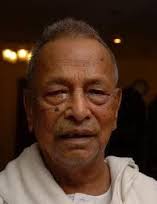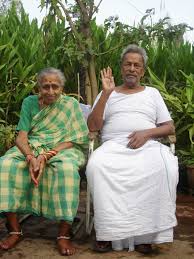About A.Nagraj
In Brief
Shri A Nagraj developed Madhyasth Darshan, also known as Jeevan Vidya, through his extensive meditative practices and realizations
- Early Life: Born on January 14, 1920, in Agrahar, Karnataka, India, A. Nagraj was deeply curious about the inconsistencies he observed in traditional scriptures and teachings.
- Spiritual Journey: He embarked on a rigorous meditative practice in the forests of Amarkantak, Madhya Pradesh, from 1950 to 1968. Through this, he attained a state of realization and developed the principles of Madhyasth Darshan based on what he 'saw'.
- Philosophical Contributions: His work focuses on understanding existence as coexistence, the conscious self, humane conduct, and establishing a humane social order via value education for consciousness development in Humankind. Shri Nagraj has provided us with a vast body of literature covering fundamental human topics.
A. Nagraj’s contributions have provided a new perspective on human existence and consciousness, emphasizing harmony and coexistence.
Detailed
Early Life
The third amongst five siblings, Shri Agrahar Nagraj Sarman was born on 14th January 1920 in the village of Agrahar, near Ramnathpura, Hassan Dist,Karnataka. The family belonged to the 'sanketi' community, and was revered at that time for their scholarship, service (seva) and hard work. They were 'ved murtis' or masters of the vedas.
Since the age of 5 of itself, young Nagraj had questions regarding the respect that the others in the village bestowed on his family. On questioning, he was informed that his family had produced scholars since many generations, hence the respect.
Nagraj did not show any interest in the scriptural studies in his family tradition (vedas). He did not receive any formal schooling. His family was quite upset with his cross questioning and lack of scholarship.
Questioning Period
During his late teens, Nagraj started studying the scriptures in order to understand them and escape being called a fool by his relatives.
On doing so, he felt there were major inconsistencies in the scriptures that his family held in utmost esteem (advaita moksha interpretation, of the vedanta). How could the world that has arisen of the ultimate truth brahman be mithya or false? Why is there is a difference in what his elders said and how they were? While India was to gain Independence soon, what is the definition of National Character? This was in 1946. Pained by these questions he visited many learned men of the time, including sri ramana maharishi and sri chandrashekhar bharati of sringeri amongst others.
They told him the only way to get answers was to see the state of Samadhi. Based on their assurance, he decided to attempt the penultimate stage in Indian Vedic thought - Samadhi, in which the 'unknown is said to become known'.
Sadhana - Spiritual Practice
He arrived in the then remote, dense, tiger infested forests of Amarkantak with his wife in 1949 - he was 30 years old then.
He performed rigorous sadhana (meditative practice) between 1949 and 1968 using the Agama tantra upasana method. He went on to realize/experience samadhi after 18 years of rigorous practice, 12 hours a day. When his basic question was unanswered even after attaining the  final Samadhi in 1968, he went on to perform an advanced stage called sanyam using a self improvised method. As a result, he was a direct witness to the ultimate reality & truth - he had realization of the fundamental nature, origins and purpose of life and the universe, of the human being and human purpose. All his questions were answered, and more.
final Samadhi in 1968, he went on to perform an advanced stage called sanyam using a self improvised method. As a result, he was a direct witness to the ultimate reality & truth - he had realization of the fundamental nature, origins and purpose of life and the universe, of the human being and human purpose. All his questions were answered, and more.
in his own words:
<quote> “Prior to Existence based human centric contemplation, I (Agrahar Nagraj, village: Agrahar, District: Hassan, State: Karnataka, India) was initiated in the practice of worship in accordance with “Spiritual knowledge- Vedic thought” . In order to quench my curiosity, I accepted the completion of the task of ‘sadhana’*, ‘samadhi’* and ‘sanyam’*. Consequently, during the period of ‘sadhana’, in the state of ‘sanyam’, I attained understanding through ‘Realization’ of ‘existence itself being and operating as co-existence’ and subsequently presented ‘Madhyasth Darshan- Sah Astitvavaad’ as a new philosophy.
I understood that ‘human tradition aligned with awakening’ and ‘human order aligned with humanity and participating in the whole order’ itself is eternal magnificence. I accepted this as ‘universal good’ and recognized the presence of the expectation of ‘goodness’ in every human. I consequently presented consciousness development based value education, humane conduct, human organization, and constitution to entire humanity.” <unquote>
Madhyasth Darshan - a new perspective to Human Knowledge
Accepting that what he had 'discovered' belonged to the entire human race, superseding religion,

race & belief, he started writing it in literature form from 1975 to 2005 - by when it assumed the form of the madhyasth darshan literature. He has presented this an as Alternative to Materialism & Idealism (Spiritualism, Theism, etc). This work does not promote or refer to any other philosophy/ darsana / body of knowledge.
Madhyasth Darshan is able to solve deep unsolved questions regarding human existence
The Jeevan Vidya Program
Since 1980, many ordinary & eminent people, many humans, came in touch with Sri Nagraj and spent substantial amounts of time trying to learn what he had understood. Many of us took to this Study seriously, recognizing it resolved all human questions. These efforts slowly took the shape of a program to disseminate this understanding among people and to bring it in school & higher education.
Sri Nagraj established the 'Jeevan Vidya program' without any established structure, or hierarchies. There is no give and take of money. The only concern for those involved is gyan, knowledge  and the Universal Good. All his efforts were to establish this understanding in others – just as a seed replicates itself; so the vision of an Undivided Human Society and Universal Order can be evidenced on this planet
and the Universal Good. All his efforts were to establish this understanding in others – just as a seed replicates itself; so the vision of an Undivided Human Society and Universal Order can be evidenced on this planet
They Study and Practice of Madhyasth Darshan is in order to understand Existence- all that exists; know ones Self, and know Human Living.
Epilogue
Shri Nagraj lived in Amarkantak from 1950 to 2016 with his wife, children and grand children. An accomplished Ayurvedic medicine practitioner, he didn't take any financial assistance from anyone. He supported his family and those of many others via agriculture, dairy and medicine.
Shri Nagraj spent the first 30 years of his life in Karnataka and the latter 66 years in Amarkantak, MP. He passed away on 05 March 2016 having lived the life of a human, having known what it is to be human, having taught what it is to be human.
* sadhana-samadhi-sanyam:
-
‘sadhana’ – taming the mind, intense mental practice.
-
‘samadhi’ – penultimate state of meditation according to Indian Vedic thought in which the ‘unknown’ is said to become ‘known’.
-
‘sanyam’ – a state of knowing beyond samadhi.
Read More
- Read the official biography here. (hindi)
- To get a glimpse into his persona, read recollections - सान्निध्य - संस्मरण - by students (hindi)
- See A.Nagraj-ji's photos (pics).
- Note by Shri Nagraj on how this darshan came about & its salient points
